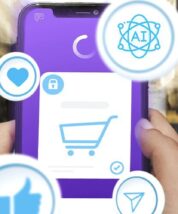Overview
But today? That model feels a bit stuck on repeat.
In a market flooded with offers, promotions, and brands all vying for our attention, customers have become skilled at spotting gimmicks. Too many rewards programs look alike. Too few deliver real value. Let’s be honest: unless they’re thoughtfully designed, most loyalty cards just don’t spark much excitement anymore.
Even when the customer loyalty program goes digital—through a digital loyalty card, a branded app, or a QR code—copying the old model into a new format isn’t enough to create customer loyalty. Because what really matters isn’t the tool itself. It’s the overall experience.
So, are loyalty programs dead?
Not at all.
But yes, they definitely need a refresh.
Customer Loyalty Program
Let’s be real: building customer loyalty in 2025 isn’t the same game it was a decade ago. And no, it’s not just about having the right tech — it’s about mindset. Today’s consumers don’t just want to be rewarded for buying.
They want to be seen, understood, and — most importantly — given a good reason to stay loyal to a brand. The old transactional approach no longer cuts it. We’ve moved into the age of relationship over repetition.
Customer expectations have shifted quickly — and dramatically:
- They expect personalisation, without feeling stalked.
- They want transparency, without the corporate jargon.
- They look for brands that share their values — and live by them.
- And they want timely, relevant communication — not spam.
In short: today’s consumers have become curators of their own experience. If a customer loyalty program doesn’t meet these expectations? It gets ignored. Or worse — deleted.
That’s why a good loyalty strategy can still be a game changer — but only if it’s built around perceived value, not just perks. It’s about what you offer on a daily basis: helpful content, meaningful gestures, thoughtful exclusives. Something that makes people want to stay, not feel obligated to.
Our Expert’s Take
« Loyalty isn’t built around products or discounts anymore. It’s about how well a brand can create a consistent, personalized, and genuinely engaging experience. You don’t ‘retain’ a customer — you give them reasons to stay. »
Smarter, More Human Loyalty Programs
Here’s the good news: loyalty programs aren’t dead.
But yes — they absolutely need to evolve.
The programs that actually work today are the ones that move beyond the « buy more, get more » logic. The ones that combine smart tech, human connection, and just the right touch of creativity. When done right, loyalty can become a serious customer engagement driver — even a real differentiator.
Here are a few trends that are reshaping the loyalty landscape:
- Smart personalisation: It’s not just « Hi [First Name] ». It’s relevant content, well-timed offers, and messages that actually reflect the customer’s journey. This is where data becomes your ally — when used wisely.
- Seamless omnichannel experiences: A digital loyalty card should work just as well in-store as it does online. Benefits should be accessible anytime, anywhere — without the customer having to wonder how or where to use them.
- Engaging formats: Think gamification, exclusive content, VIP access, immersive experiences. A great loyalty program surprises, connects emotionally, and offers more than just « 10% off your next purchase ».
- Value-driven rewards: Some brands now reward sustainable or community-minded behaviors — and that resonates strongly with younger, more purpose-driven consumers.
We’re witnessing a clear shift: from automatic rewards to a loyalty strategy that feels like a natural extension of the customer experience. It’s more thoughtful. More human. And, most importantly, more relevant.
Our Expert’s Take
« The best loyalty program doesn’t even feel like a program. It fits seamlessly into the overall experience, recognizes the customer, and grows with them. In 2025, loyalty innovation is often just smart simplicity — done well. »
A Closer Look at Today’s Loyalty Program Models
There’s no one-size-fits-all when it comes to loyalty programs. In fact, most brands today mix and match different models depending on their audience, industry, and goals.
Here’s a quick overview of the main types of customer loyalty programs we’re seeing:
- Points-based programs: The classic. Earn, accumulate, redeem. Effective when actively managed — but they can quickly fade into irrelevance if left on autopilot.
- Tiered loyalty programs: The more loyal you are, the more you get. Access to exclusive perks, early access, premium service — think Gold, Platinum, VIP levels.
- Experiential programs: Focused on creating memorable moments — events, exclusive content, personalized services — rather than just discounts.
- Community-driven programs: Customers can vote, contribute ideas, or co-create products. It builds emotional connection and a sense of belonging.
- Purpose-led or sustainable programs: Points can be converted into donations or actions that support environmental or social causes. It’s a hit with values-driven consumers.
Inspiring examples:
1. Starbucks has built a fully integrated app experience where ordering, paying, and earning rewards are all part of one seamless flow.
2. Decathlon allows members to donate their loyalty points to sports charities, turning rewards into impact.
Our Expert’s Take
« You don’t need to pick a trendy model — you need one that makes sense for your customers. A great client loyalty strategy isn’t about copying competitors, it’s about creating something that fits naturally with your brand’s DNA. »
Examples of Successful Loyalty Programs
Many brands have successfully adapted their loyalty programs to meet the new expectations of consumers, achieving significant results in terms of engagement and retention.
| Brand Name | Program Type | Key Features |
| Amazon Prime | Paid | Bundled services, continuous additions, fast delivery, streaming. |
| Starbucks Rewards | Points-based, Gamified | Ease of use, immediate rewards, personalized offers, challenges. |
| Nike Membership | Points-based, Tiered, Experiential, Gamified, Community | Transactional and experiential benefits, exclusive access, gamification via apps, member events. |
| Sephora Beauty Insider | Tiered, Points-based, Community, Personalization | Tiered system based on spending, personalized rewards, online community, early access. |
| Monoprix M' | Paid, Transactional | Discounts, cashback, free delivery for loyal customers. |
| JD Sports JD Status | Transactional | Simple "JD cash" system equivalent to euros spent. |
| Ouest France | Points-based, Innovative | Rewards in-store purchases of press and incentivizes distributors. |
Examples of Successful Loyalty Programs in 2024
Amazon Prime continues to stand out with its unique value proposition, offering not only free and fast delivery but also access to a growing range of services such as music and video streaming. The constant addition of new benefits reinforces the perception of profitability for loyal customers.
Starbucks Rewards has successfully retained a large customer base thanks to its simple point system and almost immediate rewards. The user-friendly app allows members to easily track their points, order ahead, and benefit from personalized offers, thus reinforcing engagement.
Nike Membership cleverly combines transactional benefits with exclusive experiences and gamification elements through its apps like Nike Run Club. Members benefit from privileged access to new products, exclusive events, and personalized rewards based on their level of engagement.
Sephora Beauty Insider is an example of a successful tiered program, offering increasing benefits based on customers' annual spending. The program also includes an online community where customers can exchange tips and reviews, further strengthening their connection with the brand.
Measuring What Really Matters in Loyalty
Having a loyalty program is one thing.
Knowing whether it’s actually working? That’s another story.
Too often, brands evaluate their customer loyalty program based on surface-level metrics: number of sign-ups, redemption rates, or how many points have been handed out. But let’s be honest — those numbers alone don’t tell you much about true loyalty.
What really matters is the relationship. The long-term impact.
So here are the questions worth asking:
- Are my customers coming back more often since joining the program?
- Has their average basket size increased?
- Is their Customer Lifetime Value (CLV) growing?
- Are they actively recommending the brand?
- And most importantly: is this program generating more value than it costs?
Behind those questions lie the real KPIs: repeat purchase rate, NPS, churn rate, 90-day retention, activation rate, share of revenue from members… These are the signals that tell you whether your loyalty strategy is delivering — or just existing.
And it’s not all about numbers.
Customer feedback, brand perception, and the quality of interactions are just as important. Because customer loyalty isn’t a KPI. It’s a connection you build over time.
Our Expert’s Take
« A relevant loyalty program in 2025 finds the sweet spot between measurable ROI and long-term relational value. The real question is: does your program help build a brand people actually want to stay loyal to? »
Subscribe to our newsletter and gain access to strategic insights, exclusive analyses, and expert tips to enhance your online presence.
Loyalty Doesn’t Live in a Silo: CRM, Branding, and Experience
A high-performing loyalty program rarely stands on its own. It sits at the crossroads of three strategic pillars: CRM, branding, and customer experience.
- CRM is where it all begins: data, segmentation, triggers, personalization… Without a solid CRM foundation, a loyalty initiative is running blind.
- Branding ensures your program feels like an extension of your universe — not a bolt-on. The tone, the values, the positioning… every touchpoint should reflect what your brand stands for.
- And of course, customer experience is what truly builds loyalty. Not just rewards, but smooth interactions, meaningful moments, and small surprises that make people feel valued.
When these three elements work together, your loyalty strategy becomes more than a marketing tool — it becomes a core part of how your brand connects with people.
Our Expert’s Take
« People don’t stay loyal to a program. They stay loyal to a brand that listens, understands, and makes their life easier. Loyalty is the outcome of a strong ecosystem — not a standalone goal. »
Rethinking Your Loyalty Strategy: Where to Start?
In a world where customer expectations change faster than ever, it can be tempting to scrap everything and start from scratch. But building a great loyalty program isn’t about rushing to the latest trend — it’s about designing a clear, long-term relationship strategy.
Before revamping your program or investing in the latest tech solution, take a step back and ask the right questions:
- Does your current customer loyalty program still meet your audience’s expectations?
- Is it aligned with your brand image, values, and positioning?
- Are all your channels connected — website, app, in-store — or are they operating in silos?
- And most importantly: are your customers actually getting something meaningful from it — or just another discount?
These insights will help shape a more relevant and focused loyalty strategy, built on goals that matter: retention, upsell, advocacy, emotional connection. And here’s the thing: innovation doesn’t have to mean complexity.
Sometimes, a better digital loyalty card, a clearer message, or a more intuitive customer journey can make more impact than yet another points system. Because loyalty isn’t an «add-on» at the end of a funnel — it’s the thread that runs through the entire customer experience.
Our Expert’s Take
« A strong loyalty strategy always starts with understanding your customers — not with picking a platform. The smart move? Rebuild your program around the moments that truly matter in the relationship. Then build out from there. »
What’s Next? Predictive and Adaptive Loyalty Programs
What if your loyalty program could adapt in real time to each customer’s behavior? That’s exactly where things are heading, thanks to AI and smarter data strategies.
We’re entering the era of intelligent, responsive loyalty programs — and it’s changing the game.
Here’s what’s emerging:
- Dynamic offer recommendations, based on past purchases, preferences, or real-time context
- Personalized rewards that match individual motivations — frequency, format, even tone
- Loyalty journeys that automatically adapt to customer lifecycle stages or behaviors
This is what makes a loyalty program different: it doesn’t treat everyone the same. It predicts, adjusts, and evolves — often before the customer even realizes they need something.
We're talking about loyalty strategy powered by prediction: anticipating churn, triggering proactive actions, or even suggesting better reward mechanics based on seasonality or trends. It’s still evolving — but one thing is clear: loyalty is becoming less scripted, and much more contextual.
Our Expert’s Take
« The next big shift is adaptability. Brands that build programs that grow with their customers will lead the way. Loyalty won’t be something people owe you — it’ll be something they choose. »
Conclusion – Loyalty Isn’t Bought. It’s Built.
In today’s world, customer loyalty can’t be reduced to a points card or a 10% discount. It’s become a strategic asset — a natural extension of the brand experience, and a mirror of the real value a brand brings over time.
A successful loyalty program in 2025 should be more than a rewards engine. It should be a living, connected, and meaningful ecosystem — one that’s aligned with your CRM, your brand values, and your customer experience from end to end.
At Eminence, we believe loyalty is never a given — and it’s never random.
It’s the result of a smart, well-executed loyalty strategy, built around today’s realities and tomorrow’s expectations.
That’s exactly what we help our clients build: innovative loyalty strategies that combine intelligence, emotion, and measurable performance.
Subscribe to our newsletter and gain access to strategic insights, exclusive analyses, and expert tips to enhance your online presence.
Wondering if your loyalty strategy still hits the mark — or if it’s time to rethink a few things?
Let’s chat. Whether you’re looking to fine-tune your current program or explore something completely new, we’re here to help you design loyalty experiences that feel relevant, natural… and actually work!









